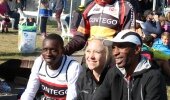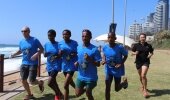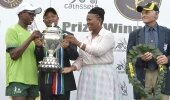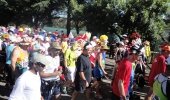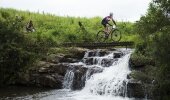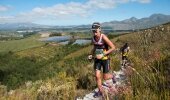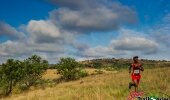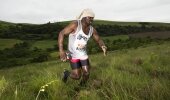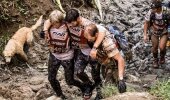Words: Lisa de Speville | Photos: Lisa de Speville & Jan Kocbach/WorldofO.com
Just as rugby dominates in South Africa but lacks popularity in, say, Costa Rica, so it is with the sport of orienteering. Participation here is small, but in Scandinavian countries entries at major events exceed that of Comrades Marathon numbers, and supporters at home sit glued to their flat screens watching live broadcasts of the events or following GPS tracking of runners online.
The principle of orienteering is simple: move at speed from control point to control point by choosing your own routes (navigating) through diverse and unfamiliar terrain using a specially created orienteering map. Sure, any map - including topographical maps and aerial images - can be used for orienteering-like events, but detailed orienteering maps prepared on a ‘human scale’ are far more accurate and allow for precise navigation. ‘Human scale’ means that features a person notices whilst moving through an area are included on the map; waist-high boulders, dense patches of vegetation (thickets) and even a one-metre deep hole in the ground will be represented on orienteering maps.
This sport of map and compass navigation has been around since the late 1800s and while ski, mountain bike and paddle orienteering are gaining popularity, foot orienteering is the oldest and most popular.
South African orienteers have been travelling abroad for some years to participate in events like the Scottish 6-Days, Sweden’s five-day O-ringen, the annual World Orienteering Championships (WOC) and Junior World Orienteering Championships (JWOC).
At the 2012 WOC in Switzerland, Johannesburg medical student Michael Crone made South African orienteering history when he made it through the qualifier and into the final of the Sprint event. This is the first time that a South African has made the final (only the top 15 runners from each of the three qualifiers go into the final) and while Crone didn’t have a great run in the final, just getting in was his goal and - like Roger Bannister’s four-minute mile - it made the rest of the local community sit up and cheer, “It can be done!”
Highly competitive
Course options at events like the WOC include Sprint (winning time of 12-15 minutes; usually more urban terrain), Middle (winning time of 30minutes) and Long (winning time of
75-90 minutes) events.
In Sprint races, the podium finishers may be separated by a few seconds and anyone more than 30 seconds off the winning time will feature lower than 15th place. Middle and Long distance courses separate the athletes a little more because of the additional distance and more demanding terrain.
“The international elite world is very competitive. However, there are a few individuals who still stand head and shoulders above the rest and are often firm favourites in certain types of terrain. Thierry Gueorgiou of France and Simone Niggli of Switzerland are two of the most notable. Thierry has dominated the Middle distance event in the sport for many years now, particularly in more technical terrain types. Simone is even more dominant and is probably the best orienteer that the world has ever seen. She has accumulated 20 world championship gold medals over the years, which is so far ahead of the next person in history that it is staggering,” explains Nicholas Mulder. A regular and consistent WOC competitor, Mulder has had the role of High Performance Manager, within the South African Orienteering Federation (SAOF), for two years. He provides coaching to the junior orienteering squad and manages the team at JWOC.
Mulder adds that there are certainly eight to 10 men in contention for individual gold medal wins at the 2013 World Orienteering Championships. The women’s field holds less depth, with only four or five women vying for the top spot.
Leading countries
“Scandinavian countries have long been a leading force in orienteering,” says Jeremy Green. He has participated in the Middle and Long distance events at a number of WOC events, most recently in 2012. He also held the ‘Development’ portfolio on the SAOF committee until he moved to the United States mid-2012. “They have a tradition of orienteering and it is a recognised and respected sport in most schools. There are even dedicated orienteering schools available for top performers,” Green adds.
Mulder lists Norway, Sweden and Finland as the top dogs. “However,” he says, “Switzerland has emerged over the last 10 years as the new big name and they can now take on and beat the other three on a regular basis, even though they have a much smaller orienteering population. Other countries with one or two good individuals that compete at the top are France, Russia and Britain.”
We’re lower down in the rankings, but we’re in good company with many other non-European countries such as Brazil, USA, Canada, Turkey and Israel. “We are even ahead of some countries like Holland and Hong Kong,” says Mulder.
As Mulder states, “The more orienteers you have, the more top orienteers you have.” Sweden, Norway and Finland have tens of thousands of active orienteers, while in South Africa we only have a few hundred regular participants.
The right terrain
Unlike straight-up running disciplines where all you have to do is run, orienteering is a dash more intensive in its requirements, as competitive orienteers must be fast off-road runners with unsurpassed navigation abilities.
Competitive and championship orienteering events are traditionally held in forested areas, but they’re not the same as our forests, which have less features. Those in the northern latitudes (Sweden, Norway, Finland and Russia) cover formerly glaciated regions. They’re termed ‘technically demanding’ as visibility is low (you can’t see other runners even 50-metres away), highly complex (many features like pits, rock and water features, ditches, knolls, vegetation variations and cliffs) and there’s random micro topography (think mini hills and valleys that overlap all over the place).
This terrain is a bit of a shock to South Africans as we typically run in rocky and grassy Highveld terrain and comparatively tame and friendly forested areas. As a result, at WOC we generally compete against other nations that also do not have much forest orienteering. Typically we’re up against Ireland, USA, Canada and Japan.
“I think that we have quite a way to go before we will be competitive in forest. You definitely need to live overseas so that you are able to compete regularly in this terrain on high-quality forest maps,” says Michael Crone. Last year Crone became the first South African EVER to make a final at the World Orienteering Championships in the Sprint event, which is more urban. The event in which Crone featured took place on a university campus.
Sarah Pope’s first international event was a five-day event in Sweden when she was only 14. She has since attended numerous Junior World Orienteering Championship (JWOC) events. “I think Michael has shown that good performances in the Sprint are possible while living here in South Africa, but good performances in Middle and Long require being out in relevant terrain multiple times a week,” she says. Pope is currently at Wits University. She and other local junior orienteers are keen to do Masters degrees at universities in orienteering countries so that they can benefit from top coaching and the right terrain for training.
Club structures
For a country’s orienteers to develop it is crucial that there are clubs with regular and structured coaching programmes, especially for young orienteers in the developmental years of childhood. “Switzerland and France have been very active here in the past and it is bearing fruit,” says Mulder.
“We’re still working at the base of the sport development pyramid, which is about getting more people into orienteering and providing coaching and support at youth level. This will result in creating 'good' orienteers. A high-performance programme is the next step to offer experience in international races and technical terrain to get them to the top.
“Switzerland and Britain have worked hard on their high-performance programmes and they’ve have been successful,” says Mulder. “However, this tends to only produce one or two world-class athletes, unless there’s constant development over numerous years through strong club structures and youth coaching,” he added.
We’re moving towards this. The South African Orienteering Federation has received funding from the Department of Sport and Recreation and the National Lottery Distribution Trust Fund to create a school orienteering programme (two levels currently available) and to train coaches. In October 2011, eight experienced orienteers from Cape Town and Jo’burg attended a coaching course presented by two trainers from the British Orienteering Federation. These orienteers aim to establish accessible and structured coaching sessions within their clubs.
Cunning running
Being a competitive orienteer is a fine balance between being a fast runner on uneven, off-road terrain and an accurate navigator able to make snap decisions on route options. “It is definitely about running faster and we also need to compete more often against other athletes at world-ranking level,” says Crone.
He had the opportunity to spend four weeks in Switzerland before racing in the WOC Sprint, where he made it through the qualifiers and into the final. Crone added, “This gave me the opportunity to get used to the mapping style and I was also able to race often against faster runners before the WOC.”
Green agrees that there’s a need for more speed from South African orienteers. “This implies that we need to train orienteers to run faster or attract fast runners to orienteering. Orienteers don't have to be super fast, but they do need to be faster than we are currently to be competitive on the world stage - like running five kilometres in 15minutes type of fast.”
Green commends Crone’s focus and commitment to training, which paid off at WOC. “Arguably he is the only athlete since Nicholas [Mulder] to really take orienteering seriously. He got a training plan and followed it and he attended athletics training at Wits with top cross-country and track athletes. Michael trained for orienteering weekly, more than simply attending the regular weekend club events and occasional training camps.”
Yes, we can!
Orienteering in South Africa has come a long way in 30 years, but it still has a way to go before our runners are in the top rankings at big events abroad. Crone proved that a sufficiently motivated athlete, with the resources currently available here, can make the Sprint final at WOC. And with more coaching and international training opportunities, it is only a matter of time before the current junior orienteers make their mark in the Middle and Long events. •
dinFO
World Games
Orienteering features in the World Games, a major sporting event that happens every four years (in the year following the Olympic year) and includes sporting disciplines that are not contested at the Olympics. Orienteering first featured in 2001 and will again be presented at the 2013 World Games in Colombia.
School orienteering
The SAOF has developed a school orienteering programme. The first level, ‘O in a Box’ Level 1 does not require the school to be mapped, nor does the teacher require any orienteering experience.
The necessary equipment for the games and activities is provided to the school free of change during a one-hour handover where interested teachers are taught how to play the many orienteering games. Here, the focus is on teaching map orientation, representation and the relationship between symbols on a map and features on the ground and distance and scale.
The second ‘O in a Box’ level is a little more map focused, although most of the games do not require the school to be mapped. Again the teacher needs nothing more than an interest in orienteering to run the activities. Orienteering experience helps, but is not necessary.
The annual Gauteng Orienteering Schools League runs from February to March.
For more on this contact:
or visit www.orienteering.co.za.


